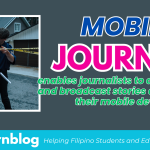Mobile journalism (MoJo) is the practice of reporting news using mobile devices like smartphones and tablets. It involves capturing, editing, and distributing news content on the go, using various apps and tools for video, photo, audio, and text production. MoJo is popular due to its flexibility, speed, and the ability to cover stories from virtually anywhere.
MoJo has become increasingly rampant in recent years due to several factors that align with changes in technology, media consumption habits, and the demands for more immediate and engaging news. The rise of mobile phones has led to the rise of citizen journalism, where regular individuals can capture newsworthy events and share them instantly. Media outlets are increasingly relying on user-generated content as a way to break stories or supplement their own coverage, often integrating this into larger narratives or offering quick analysis.

Photo courtesy: Pexels
What are the key features of Mobile Journalism?
1. Portability. Journalists can cover stories anywhere, even from remote or dangerous locations.
Instant Publishing: Content can be edited and shared in real-time, ensuring timely updates.
2. Multimedia Use. It combines photos, videos, podcasts, and text, all created using the mobile device.
3. Social Media Integration. Direct integration with social media platforms for quick dissemination and audience engagement.
Pitching Topics for Mobile Journalism
When pitching topics for MoJo, you should consider the unique aspects of mobile reporting, such as portability, immediacy, and audience engagement. Here are some tips for crafting a strong pitch:
- Timely and Relevant Stories: Focus on topics that are time-sensitive or trending. MoJo thrives on breaking news, live coverage, or real-time updates. Consider stories that can evolve quickly or need to be covered from different locations.
- Location-Driven Content: Mobile journalism is excellent for location-based stories. Think of stories that require you to be on-site, such as disaster coverage, protests, local events, or interviews with community leaders. Highlight how your pitch benefits from being shot and edited on location.
- Visual Appeal: Since mobile journalism relies heavily on multimedia, choose topics with strong visual elements. These could include human interest stories, sports events, festivals, or visually striking developments (e.g., construction, protests, wildlife).
- Interactivity and Engagement: Consider stories that encourage audience interaction, such as polls, live Q&A sessions, or citizen-generated content. Mobile journalism is also great for live-streaming events or showcasing real-time reactions.
- Easy to Digest: Since mobile devices are often used for brief consumption, focus on stories that can be broken down into short, punchy segments. Think about a compelling headline or hook that draws attention immediately.
- Feature Series or Regular Updates: You can pitch a recurring story or series that fits the mobile format, such as “Day in the Life” segments, interviews, or progress on long-term stories that can be updated in real-time.

Photo courtesy: Pexels
Example Pitches:
“The Power of Youth: Local Teenagers Organizing a Charity Event” – A story that covers a community event organized by young activists. It’s visually engaging and timely, perfect for live updates and audience interaction through social media.
“Protests Erupt: Live Coverage of the City’s Street Demonstrations” – A real-time report from a protest site with live streams and quick video interviews, offering immediate news from the ground.
“Behind the Scenes: A Day in the Life of a Local Farmer” – An immersive story that shows the challenges and rewards of a local farmer’s life, shot in a way that gives viewers an intimate look through mobile video.
Mobile journalism’s rapid growth is driven by technological advancements, the shift to digital media, and the demand for fast, engaging, and cost-effective reporting. With the increasing reliance on smartphones and social media for news consumption, MoJo offers both a practical and efficient way to cover stories in real-time, engage audiences, and adapt to the ever-changing media landscape.











